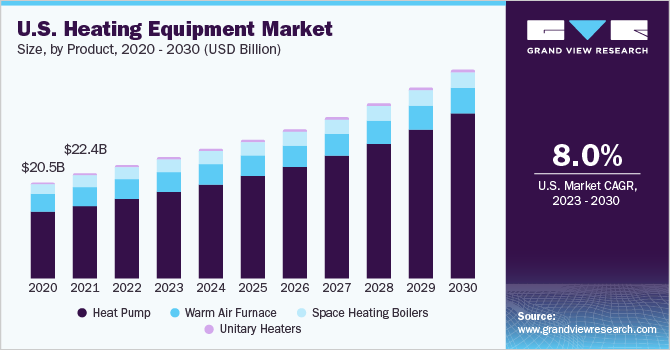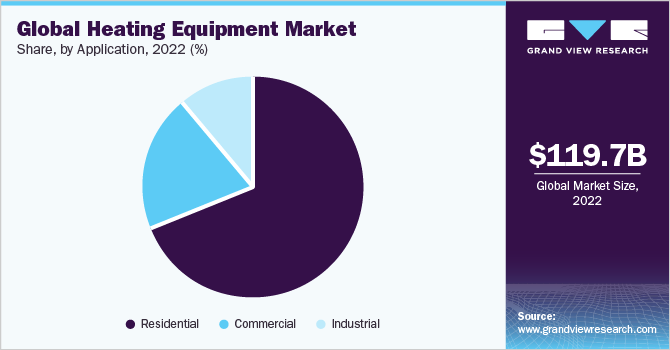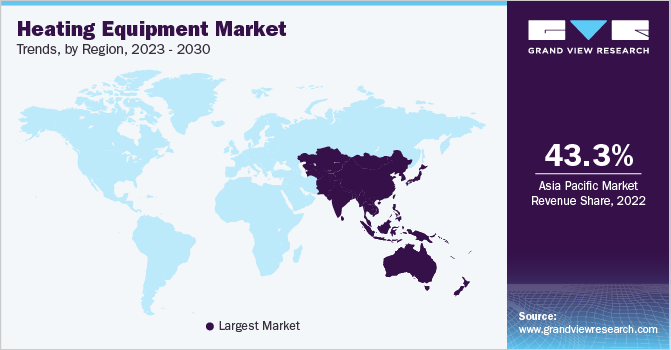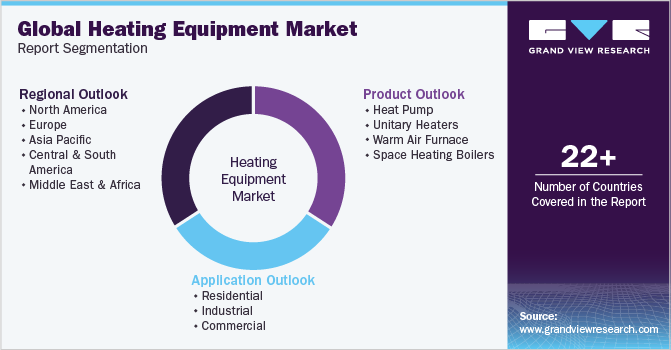- Home
- »
- Advanced Interior Materials
- »
-
Heating Equipment Market Size And Share Report, 2030GVR Report cover
![Heating Equipment Market Size, Share & Trends Report]()
Heating Equipment Market Size, Share & Trends Analysis Report By Product (Heat Pump, Unitary Heaters, Warm Air Furnaces), By Application (Residential, Industrial), By Region, And Segment Forecasts, 2023 - 2030
- Report ID: GVR-1-68038-206-8
- Number of Pages: 169
- Format: Electronic (PDF)
- Historical Range: 2018 - 2021
- Industry: Advanced Materials
Report Overview
The global heating equipment market size was estimated at USD 119.7 billion in 2022 and is expected to grow at a compound annual growth rate (CAGR) of 7.7% from 2023 to 2030. Increasing construction spending, coupled with rising demand for highly energy-efficient heating solutions, is projected to drive the demand for heating equipment. Furthermore, favorable government initiatives such as rebates and incentives for the installation of highly energy-efficient heating equipment are projected to have a positive impact on the market.

Heating equipment plays a crucial role in the processing and manufacture of ferrous & non-ferrous metals, mining, oil & gas, and the automotive industry. The demand for heating equipment that lower operational costs and improves energy savings are anticipated to increase as energy consumption for industrial and residential applications. Global energy consumption has increased dramatically due to the expanding population and rapid industrialization. Large quantities of processed heat are utilized by many industrial production processes and methods, which typically result in high energy expenditures for organizations. These aforementioned factors are anticipated to drive demand for the market.
According to the U.S. Department of Energy, a tax credit of approximately 30% can be claimed for buying a property in the U.S. with qualified heat pumps installed in an existing or new dwelling unit. In addition, other initiatives undertaken by the Government of the U.S. are related to encouraging the adoption of ground-source heat pumps. The California Energy Commission passed a building energy code in August 2021 that promotes using heat pumps for space and water heating applications in newly constructed buildings in the state. Such initiatives are expected to contribute to the demand for heating equipment in the U.S. in the coming years.
Commercial heating is a crucial factor in the transition of establishments equipped with fossil fuel-based systems in the U.S. to buildings incorporated with renewable energy-based systems since it accounts for a considerable share of the energy consumption of the country. For instance, the Governor of Maine has proposed the installation of 100,000 high-performance heat pumps in homes and businesses in the state by 2025. Moreover, Maine is also making significant headway by having installed over 28,000 high-efficiency heat pumps just one year after making the commitment. These factors are expected to drive the demand for heating equipment in the U.S. over the forecast period.
According to the International Energy Agency, heat pumps continue to cover only a small portion of domestic heat demand, while fossil fuel-based systems accounted for approximately half of the global heating equipment sales in 2020, with most heat pumps being installed in new buildings. However, various factors, including regulatory developments that promote the use of heat pumps in new buildings and surging air conditioning requirements, are expected to fuel the adoption of heating equipment in the coming years.
Heating equipment growth is expected to be boosted by rising building spending and increased maintenance and replacement activity. The building industry in the U.S. is focused on developing environmentally friendly and energy-efficient constructions. The U.S. Green Building Council (USGBC) founded the Leadership in Energy and Environmental Design (LEED) accreditation program. LEED focuses on lowering energy usage through the design and development of energy-efficient projects. HVAC systems must meet the specifications stated in the New Buildings Institute, Inc. article "Advanced Buildings: Energy Benchmark for High-Performance Buildings." Such policies have also facilitated the development and implementation of ecologically sustainable alternatives such as heating equipment.
Product Insights
The heat pump product segment led the market and accounted for 68.2% of the global market share in 2022. Heat pumps are widely used in regions that require moderate heating and cooling. Heat pumps are also known as two-way air conditioners because they help extract heat from cold temperatures outside using an electrical system and discharge that heat inside the house. In summer, the operations of a heat pump are reversed, which helps keep the interiors cooler by extracting heat from indoors. These factors are anticipated to drive the demand for heat pumps in the projected period.
Unitary heaters segment is anticipated to witness a CAGR of 3.9% over the forecast period. These are commonly utilized in the commercial sector to address the space heating needs of small complexes or rooms. Unitary heaters have a low starting cost and an easy installation procedure. These reasons are expected to fuel market growth in the coming years. For instance, Warren Technologies provides unitary electric heaters in various sizes, shapes, and configurations that can be field mounted in any brand of air conditioning system.
The market for warm air furnaces is expected to be driven by proper conditioning of the air offered by warm air furnaces as compared to other heating systems. Furthermore, most warm air furnaces are provided with humidification. This helps to eliminate indoor air contaminants and humidity issues that can cause property damage and health issues. These factors are expected to positively impact product demand during the forecast period.
Space heating boilers are a crucial part of the heating systems in both residential and commercial applications. Condensing space heating boilers are another effective technology that can heat buildings and produce domestic hot water. As they 'condense' the water vapor created during combustion into liquid form, they are referred to as 'condensing' processes. To warm the cold water entering the boiler, the heat from the water vapor is recycled. By using this procedure, it is made sure that most of the energy generated during combustion is used to heat the building. These factors are further expected to propel the market demand in the coming years.
Application Insights
The residential application segment led the market and accounted for 68.5% of the global market share in 2022. Heating systems used in single- and multi-family homes, including houses and apartments, are included in this segment. For instance, instantaneous water heaters or consumer storage are the most popular kinds of water heaters in single-family houses. A central domestic hot water system with storage boilers and water heaters connected to a storage tank to serve the entire building are the two alternatives that are most frequently utilized for multi-family buildings.
The industrial application segment is anticipated to witness a CAGR of 6.9% over the forecast period. Industries such as mining, oil & gas, metal processing, food & beverage, and others for processing, manufacturing, space, and water heating use heaters (or other heat-processing machinery like dryers, ovens, or burners) and the heat they produce to expedite, complete, and carry out their processes, this is referred to as industrial process heating.

In many industrial procedures, sufficiently controlled heat must be used due to the demand for quality. Electric heaters provide good process temperature control. The variation of weather patterns and intensification of winters are other factors contributing to the use of industrial heating. In the regions, there is a cyclical requirement for heating apparatus that can be utilized to heat, melt, or maintain specific temperatures. These aforementioned factors are expected to drive the demand for heating equipment in industrial applications in the coming years.
Commercial heating equipment such as heat pumps and destratification heating is used to heat the buildings in which they are located, but many enterprises also need additional heat for high-energy activities like distilling, drying, baking, and other uses. Numerous heating systems are appropriate for commercial structures, such as for big spaces that need a constant temperature, warm air space heating uses a blower to draw air through a heat exchanger. Moreover, heat pumps are another way to heat a space by transferring heat from the air to refrigeration coolant, which is then squeezed to dramatically raise the temperature. The heat pump's indoor unit receives this coolant before pumping it back into the building.
Regional Insights
Asia Pacific region dominated the market in 2022 by accounting for a share of 43.3% of the market owing to the massive investments by the governments of different countries in the region for the development of public infrastructure and the expansion of residential construction. Furthermore, there is rising awareness regarding energy saving across the region, which is expected to increase the market demand further.

The growing need to adopt energy-efficient solutions in Central & South America to maintain low operating costs is one of the primary factors driving the demand for the market during the forecast period. The demand for upgraded solutions and the replacement of existing heating equipment with heat pumps is projected to augment the market growth. Companies operating in the heat pump industry also benefit from the revenue obtained through maintenance contracts and other customization demands from end-use sectors.
North America region is expected to witness a CAGR of 7.9% over the forecast period. Major heating equipment manufacturers in this region are focusing on providing energy-efficient equipment that provides appropriate heating, has low maintenance and operational expenses, and emits lower amounts of pollution. Furthermore, rising demand for low-noise operations, integration of heating equipment with solar panels, and increased usage of sensors are projected to enhance the market demand in the forecast years.
Increasing construction activities in the Middle East, coupled with the launch of new oil & gas projects in the region, are anticipated to fuel the growth of the construction sector in the Middle East. Some of the key countries in the Middle East & Africa include Saudi Arabia, the UAE, Qatar, Oman, Egypt, and South Africa. The construction sector of the region is projected to witness significant growth in the coming years owing to strong support of the local governments for infrastructure development.
Key Companies & Market Share Insights
The manufacturers adopt several strategies, including geographical expansions, product launches, and mergers & acquisitions, to enhance market penetration and cater to the changing technological requirements of various applications such as residential, commercial, industrial, and residential. For instance, in April 2023, LG Electronics opened its factory for production of heat pumps in the U.S. The factory will make 100% electrical units, with future intentions to produce outdoor heat pumps.
Further, in February 2023, Lennox International introduced the Dave Lennox Signature Collection model SL25XPV heat pump to deliver complete comfort with ideal air at home. The product is recognized as one of the most efficient ENERGY STAR-certified items for lowering greenhouse gas emissions and satisfying high energy efficiency criteria set by the U.S. Environmental Protection Agency, with an efficiency rating of up to 11.8 HSPF and 24 SEER. Some prominent players in the global heating equipment market include:
-
Carrier
-
Mitsubishi Electric Corporation
-
Emerson Electric Co.
-
Daikin Industries, Ltd
-
Trane
-
Robert Bosch GmbH
-
Lennox International
-
Johnson Controls, Inc.
-
Midea Group
-
Hitachi, Ltd.
-
Rheem Manufacturing Company
-
Haier (General Electric)
-
Panasonic Holdings Corporation
-
Danfoss
-
Fujitsu
-
LG Electronics, Inc.
-
Samsung
Heating Equipment Market Report Scope
Report Attribute
Details
Market size value in 2023
USD 127.8 billion
Revenue forecast in 2030
USD 216.3 billion
Growth rate
CAGR of 7.7% from 2023 to 2030
Base year for estimation
2022
Historical data
2018 – 2021
Forecast period
2023 – 2030
Quantitative units
Revenue in USD billion and CAGR from 2023 to 2030
Report coverage
Revenue forecast, company market position analysis, competitive landscape, growth factors, and trends
Segments covered
Product, application, region
Regional scope
North America; Europe; Asia Pacific; Middle East & Africa; Central & South America
Country Scope
U.S.; Canada; Mexico; Germany; France; Italy; Sweden; Norway; Spain; Finland; China; India; Japan; Australia; South Korea; Brazil; Argentina; Saudi Arabia; UAE
Key companies profiled
Carrier; Mitsubishi Electric Corporation; Emerson Electric Co.; Daikin Industries, Ltd; Trane; Robert Bosch GmbH; Lennox International; Johnson Controls, Inc.; Midea Group; Hitachi, Ltd.; Rheem Manufacturing Company; Haier (General Electric); Panasonic Holdings Corporation; Danfoss; Fujitsu; LG Electronics, Inc.; Samsung
Customization scope
Free report customization (equivalent up to 8 analysts working days) with purchase. Addition or alteration to country, regional & segment scope.
Pricing and purchase options
Avail customized purchase options to meet your exact research needs. Explore purchase options
Global Heating Equipment Market Report Segmentation
This report forecasts revenue growth at global, regional & country levels and provides an analysis on the industry trends in each of the sub-segments from 2018 to 2030. For this study, Grand View Research has segmented the global heating equipment market based on product, application, and region:

-
Product Outlook (Revenue, USD Billion; 2018 - 2030)
-
Heat Pump
-
Unitary Heaters
-
Warm Air Furnace
-
Space Heating Boilers
-
-
Application Outlook (Revenue, USD Billion; 2018 - 2030)
-
Residential
-
Industrial
-
Commercial
-
-
Region Outlook (Revenue, USD Billion; 2018 - 2030)
-
North America
-
U.S.
-
Canada
-
Mexico
-
-
Europe
-
Germany
-
France
-
Italy
-
Sweden
-
Norway
-
Spain
-
Finland
-
-
Asia Pacific
-
China
-
Japan
-
Australia
-
India
-
South Korea
-
-
Central & South America
-
Brazil
-
Argentina
-
-
Middle East & Africa
-
Saudi Arabia
-
UAE
-
-
Frequently Asked Questions About This Report
b. The global the heating equipment market size was estimated at USD 119.7 billion in 2022 and is expected to be USD 127.8 billion in 2023.
b. The heating equipment market, in terms of revenue, is expected to grow at a compound annual growth rate of 7.7% from 2023 to 2030 to reach USD 216.3 billion by 2030.
b. Asia Pacific regional segment dominated the market in 2022 by accounting for a share of 43.3% of the market owing to the massive investments by the governments of different countries in the region for the development of public infrastructure and the expansion of residential construction. Furthermore, there is rising awareness regarding energy saving across the region, which is expected to augment the market demand further.
b. Some of the key players operating in the heating equipment market include Carrier, Mitsubishi Electric Corporation, Emerson Electric Co., Daikin Industries, Ltd, Trane, Robert Bosch GmbH, Lennox International, Johnson Controls, Inc., Midea Group, Hitachi, Ltd., Rheem Manufacturing Company, Haier (General Electric), Panasonic Holdings Corporation, Danfoss, Fujitsu, LG Electronics, Inc., Samsung.
b. Increasing construction spending, coupled with rising demand for highly energy-efficient heating solutions, is projected to drive the demand for heating equipment. Furthermore, favorable government initiatives such as rebates and incentives for the installation of highly energy-efficient heating equipment are projected to have a positive impact on the market.
Share this report with your colleague or friend.
![gvr icn]()
NEED A CUSTOM REPORT?
We can customize every report - free of charge - including purchasing stand-alone sections or country-level reports, as well as offer affordable discounts for start-ups & universities. Contact us now
![Certified Icon]()
We are GDPR and CCPA compliant! Your transaction & personal information is safe and secure. For more details, please read our privacy policy.
We are committed towards customer satisfaction, and quality service.
"The quality of research they have done for us has been excellent."





